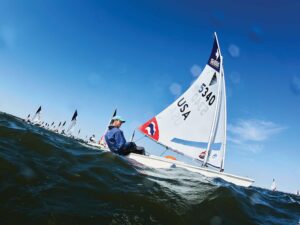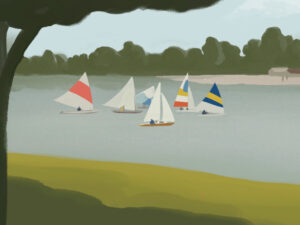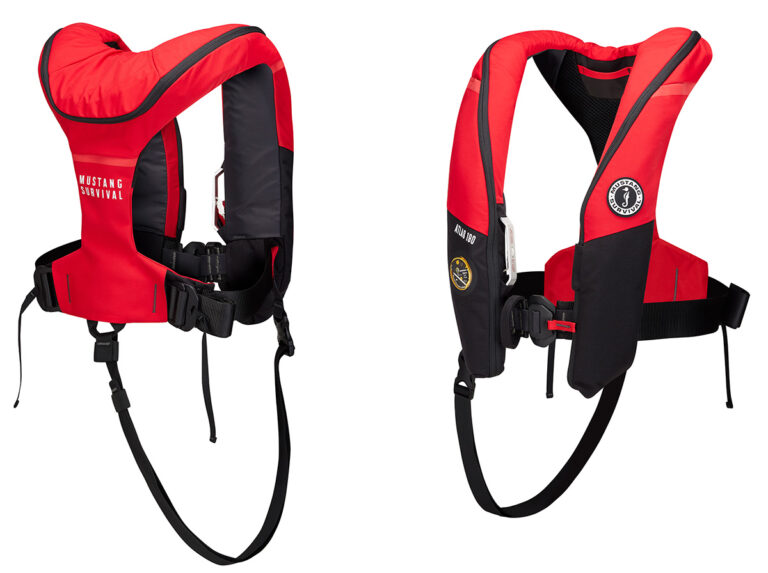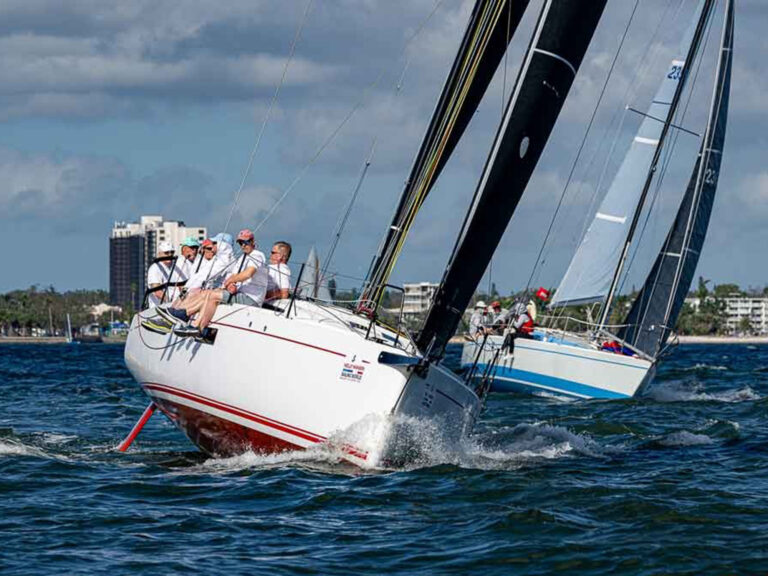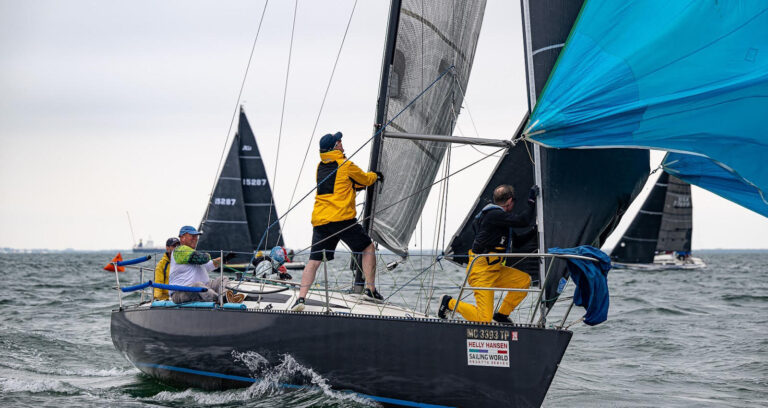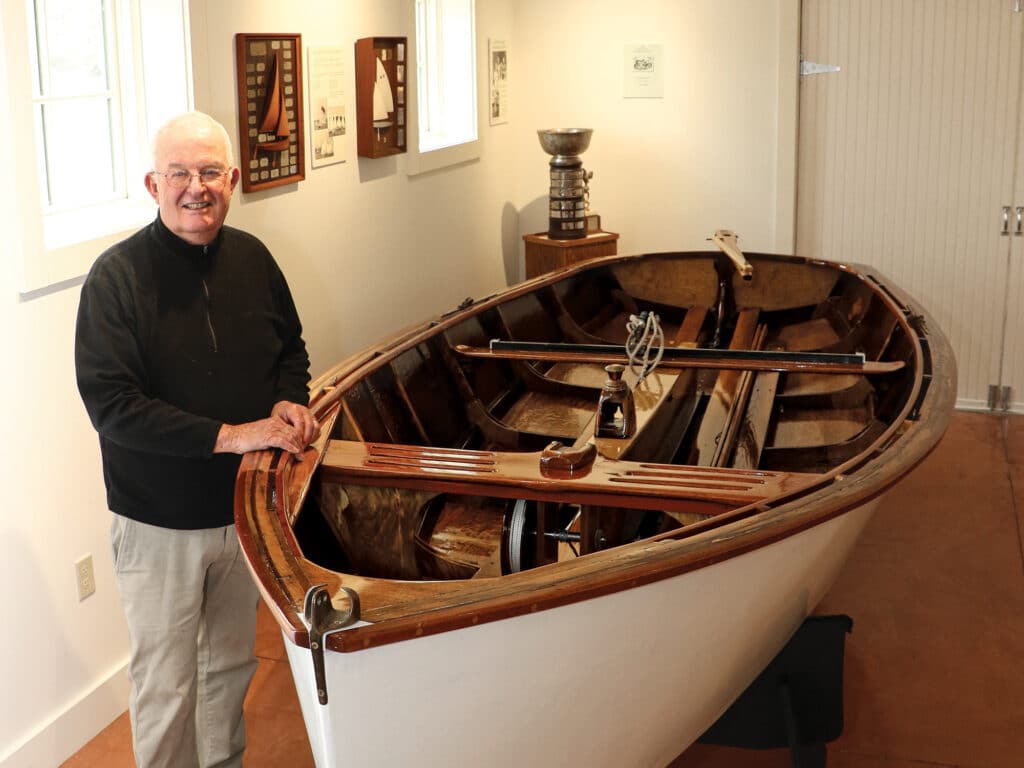
The Rhodes Bantam sloop is an open racing dinghy designed by renowned naval architect Philip Rhodes in the mid-1940s. At 14 feet, 325 pounds, and with 130 square feet of working sail (including a large genoa jib and a large spinnaker set on a 7-foot-long spinnaker pole), it was a hot boat in its day. The first wood Bantams were produced by the Skaneateles Boat Company in the Finger Lakes region of upstate New York and were an instant hit after World War II. Eventually, nearly 2,000 boats were produced, first in wood but later in fiberglass. Fleet racing was active in upward of 30 fleets, and the Rhodes Bantam Class Association held an International Regatta every summer at venues as widespread as New York, Pennsylvania, Ohio, Michigan, Illinois and Mississippi.
At age 15—63 years ago—I fell in love with the Bantam and persuaded my father to share in the purchase of a new Gibbs Boat Company wood boat, Hull No. 836. I sailed and raced that boat through high school on Acton Lake near Oxford, Ohio, and then traded it for a new wooden Baycraft-built hull, No. 1257, when I was in college.
After college, graduate school and a five-year hitch in the Air Force, I settled in upstate New York, sold No. 1257, and bought No. 1775 Spirit from legendary dinghy racer and builder Dick Besse in nearby Skaneateles, New York. My late son and I won the Rhodes Bantam International Regatta with this boat in 1981 and 1983. She was a joy to sail in a fresh breeze.
Like many two-person racing dinghy classes, the Rhodes Bantam class fell on hard times in the late 1970s as new classes came on the scene and younger sailors gravitated to Lasers and crewing on larger one-designs. By the end of the 1980s, only a few fleets remained, and the class no longer held its annual International Regatta. A few reunion regattas were held in conjunction with other regattas in upstate New York, but the class simply faded away for all practical purposes.
Fast-forward to 2009. The Skaneateles Historical Society operates a lovely museum called the Creamery in the Village of Skaneateles. The museum has displays that chronicle the history, culture and industry of the region, with an impressive collection of small craft built and sailed in Skaneateles. A few years ago, the society acquired Skaneateles-built Lightning No. 1 on a long-term loan from the Mystic Seaport Collection, and it is now on display in a new wing of the museum.
The family of the late Dick Besse also donated his last Bantam build to the museum, R-B No. 1823 Woodwins, an all-wood creation right down to the Sitka spruce spars. This boat is a real beauty and was displayed next to Lightning No.1.
The Skaneateles Historical Society, however, had an interest in acquiring a much older, historical Rhodes Bantam for its collection. Knowing of my interest in the class, one of the society board members approached me to see if I was interested in finding a suitable candidate. I readily agreed, but little did I know the search would take the better part of six years.
I immediately started my quest to find the oldest surviving Bantam in existence. A quick internet search turned up Lawrence Fortunato’s excellent Rhodes Bantam website and photo gallery, which also featured a bulletin board where visitors to the site could post comments. Sure enough, a gentleman named Charles Jannace posted that he had owned Rhodes Bantam No. 1 from 1954 to ’55 and had sailed it on Little Neck Bay on Long Island. Then came another post from a gentleman named Alexander Scott, who said his family had owned and raced Bantam No. 2. Scott also stated that No. 1 was no longer in existence, and his father, Fred Scott, who had worked for the Skaneateles Boat Company, had redesigned the interior. No. 2, he said, was the actual production prototype for all the subsequent Skaneateles-built wood Bantams. Fred Scott went on to design several popular small sailboats, most notably the Force 5 and the Puffer. Alexander Scott left a telephone number on the website, and the hunt for No. 2 was on.
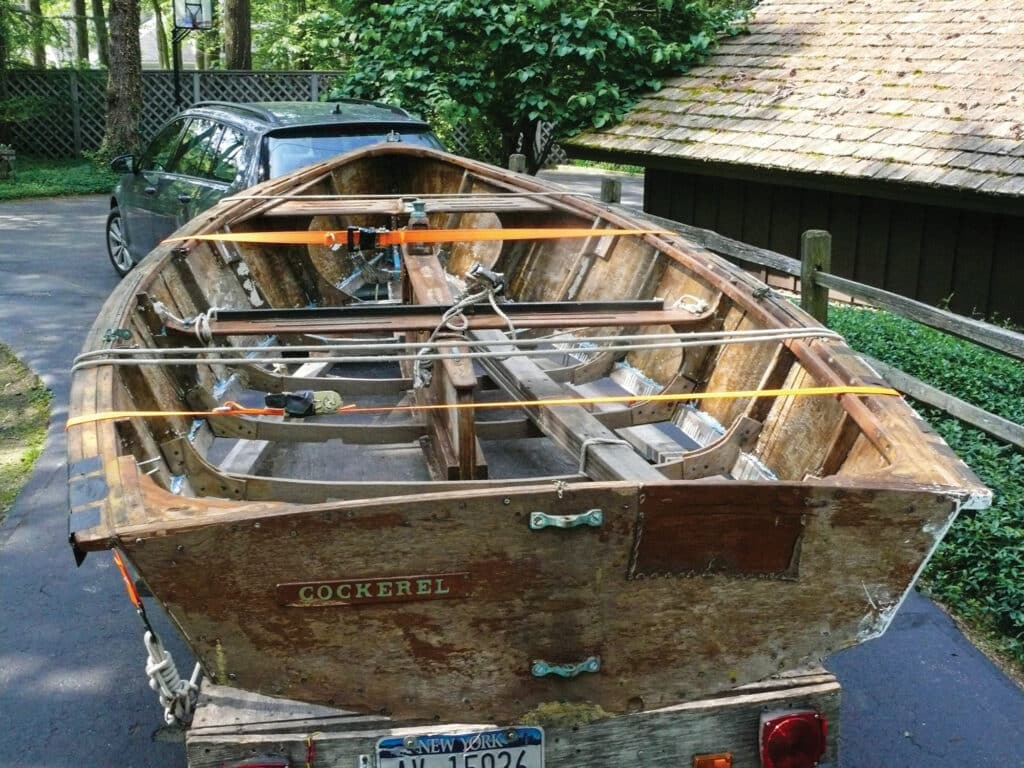
I called him and explained my interest in finding the boat. The call also reminded me that I had actually sailed on No. 2 with Alexander’s brother, Rick Scott, one summer afternoon in 1963 when I was on vacation in Skaneateles. (I was 19 at the time.) I also learned that No. 2, named Cockerel, had quite the racing pedigree, having won the R-B International Regatta in 1949 and again in 1953. Alexander explained that his family had sold it to an attorney named Larry Hale, who lived somewhere in Massachusetts.
After a little more internet sleuthing, I found a website for Lawrence Hale, Esq. in Carver, Massachusetts. Using the firm’s website, I emailed Hale, and he confirmed that he had purchased No. 2 in 1981, did some work on it, and even took it on his honeymoon in Maine in 1984. He also explained that he had given the boat to Reverend Cuthburt Mandell, the rector of the Aquia Episcopal Church in Stafford, Virginia. Naturally, I found an email address for the reverend, wrote to him, and found that he had owned No. 2 but ended up giving it to somebody who lived on Cape Cod. That’s where the trail went cold; he had no name, address or telephone number.
Then, somewhat out of the blue, Mandell contacted me again and said he learned that the name of the last known owner of No. 2 was Mark Sherwin, an artist on Cape Cod. I now had a name but no other contact information.
Anyone familiar with Cape Cod knows there are a lot of artists who live there. It’s also known to be a bit of a graveyard for boats of all types and sizes. A cursory web search yielded no match, but I persisted and did numerous web searches with different search words in my spare time. Finally, I found a post on an obscure artists website where—ta-da—one Mark Sherwin had posted and left—ta-da again—a cellphone number.
I immediately called and, after leaving a few messages, finally had a live telephone conversation with Sherwin. He confirmed he was indeed the current owner of R-B No. 2 and might be interested in selling or donating it for my museum project. He stated that he would contact me in a few months, and we could work something out. I was elated, but my elation was premature.
Months passed, and I did not hear from him. I tried to reach him again, but calls and emails went unanswered. I suddenly had this image of the hulk of R-B No. 2 sitting on the bank of a salt marsh somewhere on the Cape, slowly but surely rotting away.
But I had one other lead. A neighbor in Cazenovia, New York, where I live, had spent a lot of time on Cape Cod and knew the Sherwin family. He made a few inquiries, and low and behold, Sherwin emailed him at the end of August 2015, referenced my earlier contact, and expressed an interest in selling the boat.
Apparently, Sherwin had been dealing with serious health problems that might have accounted for some of our earlier miscommunications. But I now had a valid email address, home address and telephone number for him. I wrote and called him right away.
Over the following few weeks, we corresponded regularly. I learned that his son, a sailmaker in Seattle, had removed the 1/4‑inch plywood bottom from the hull and replaced several damaged mahogany frames aft of the centerboard trunk. It was also missing a mast and a tiller handle. Sherwin emailed me several good photos. We agreed on a fair price that would cover his storage costs over the years and restoration efforts to date, and settled on a pickup date.
On October 14, 2015, I pulled up to Sherwin’s house in Sandwich and saw No. 2 for the first time in 52 years. As advertised, the bottom was missing, but his son had done a fine job of replacing several damaged mahogany frames. There were only pieces of the mast left, no tiller handle, and the rudder was a kick-up design not original to the boat. As is, the boat was not going to win any beauty contests, but she had “good bones,” as they say, and could be restored to display condition with a new plywood bottom, a lot of sanding, paint, varnish and some new period-correct components. Sherwin could not have been more gracious. I am sure he had some regrets about parting with this boat, but I sensed that he shared my vision of where it should spend the rest of its days. We closed the deal, and I was off to brave the hazards of the infamous Bourne Bridge rotary and the Mass Pike back to my home in Cazenovia.
I suddenly had this image of the hulk of R-B No. 2 sitting on the bank of a salt marsh somewhere on the Cape, slowly but surely rotting away.
The boat and gear spent the winter in my barn, but I trailed the hull over to Skaneateles the following spring and formally donated it to the Historical Society. Dave Miller and John Barnes, two of the active society members, agreed to work on the hull, and I agreed to find the missing parts (mast, rigging, and the rudder/tiller assembly) and restore them and some other parts to display condition. Luckily, I found an almost-free 200 series Bantam barn-find derelict in nearby Tully, New York, that yielded all the period-correct missing parts and gear. Miller and Barnes cleaned the hull, fitted a new plywood bottom, and were well on the way when COVID-19 hit and everything came to a halt for the better part of two years.
The museum staff and I finally elected to do a fundraiser focused on former Bantam sailors and then contracted out the rest of the restoration to Todd Kallusch in Sodus, New York. His family used to build beautiful wood Bantams, and he did an inspired job of finishing the restoration.
Miller did the final work of displaying the boat at the museum, and we rounded up vintage photos, and even found and displayed the first-, second- and third-place International Championship Regatta perpetual trophies. The display has been a popular exhibit since it opened in 2022.
There are really two stories here. The first is about the birth, life and eventual demise of a fine sailboat class. The second is about how to find a 70-year-old relic so people can see it and reflect on just what a great little boat it was. I am happy to have been part of both stories, and while I have mixed feelings about the internet, I would have gotten nowhere in my nautical treasure hunt without it. If you are ever in Skaneateles on a Friday afternoon when the museum is open, gaze at the beautiful lake, have a beer at the Sherwood Inn on Genesee Street, then take the short walk to the Creamery on Hannum Street and enjoy being in the presence of its collection of wonderful old boats and associated displays. And give No. 2 a good look. She’s worth it, as was the hunt to find her.

